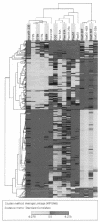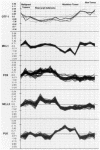Genetic expression profiling of parotid neoplasms by cDNA microarrays
- PMID: 16450770
- PMCID: PMC2639868
Genetic expression profiling of parotid neoplasms by cDNA microarrays
Abstract
Differentially expressed genes in various benign and malignant salivary gland tumours were identified by use of cDNA microarrays containing 19,000 human expressed sequence tags. Samples were derived from 5 patients with pleomorphic adenoma, 4 with Warthin's tumour, one with clear cell carcinoma, and 2 with mucoepidermoid carcinoma. Tumours were classified by using a subset of 486 genes. Benign Warthin's tumour and pleomorphic adenoma showed very distinctive gene expression patterns. A total of 133 genes differentiated the single malignant clear cell carcinoma from non-tumour salivary glands (p < 0.01), whereas only 16 genes separated it from the highly related benign pleomorphic adenoma (p < 0.01). A total of 57 cDNAs were associated with mucoepidermoid carcinoma (p < 0.01). The results show gene expression alterations common to all tumours and unique to each benign and malignant tumour. The numerous Expressed Sequence Tags of unknown function we identified could also become useful as tumour markers and represent a set of novel tumour-associated genes.
Sono stati identificati con l’uso di cDNA microarrays contenenti 19.000 sequenze geniche, differenti geni espressi in tumori benigni e maligni delle ghiandole salivari. I campioni sono stati ricavati da 5 pazienti affetti da adenoma pleomorfo, 4 da tumori di Warthin, 1 con carcinoma a cellule chiare e 2 con carcinoma muco-epidermoidale. Questi tumori sono stati classificati usando un subset di 486 geni. Il tumore di Warthin e l’adenoma pleomorfo hanno mostrato un pattern di espressione genica estremamente tipico. Il campione di carcinoma a cellule chiare ha dimostrato 133 geni differenti rispetto al tessuto salivare normale (p < 0.01), solo 16 geni lo differenziano dall’adenoma pleomorfo (p < 0.01), mentre 57 geni erano associati al carcinoma muco epidermoidale (p < 0.01). Questi risultati dimostrano che esistono alterazioni dell’espressione genica comuni a tutti i tumori e altre esclusive per i tumori benigni e/o maligni. Sono stati anche identificati numerosi Espressed Sequence Tags, la cui funzionalità è ancora sconosciuta e che potrebbero essere usati come marker tumorali e rappresentare un nuovo gruppo di geni tumore associati.
Figures


Similar articles
-
Identification of differentially expressed genes in human salivary gland tumors by DNA microarrays.Mol Cancer Ther. 2002 May;1(7):533-8. Mol Cancer Ther. 2002. PMID: 12479271
-
Gene expression profiling of differentiated thyroid neoplasms: diagnostic and clinical implications.Clin Cancer Res. 2004 Oct 1;10(19):6586-97. doi: 10.1158/1078-0432.CCR-04-0053. Clin Cancer Res. 2004. PMID: 15475448
-
Surgical management of epithelial parotid tumours.J Coll Physicians Surg Pak. 2004 Jul;14(7):394-9. J Coll Physicians Surg Pak. 2004. PMID: 15279739
-
Parotid gland tumours. Our experience and a review of the literature.Chir Ital. 2003 Nov-Dec;55(6):857-64. Chir Ital. 2003. PMID: 14725226 Review.
-
[Transcriptomes for serial analysis of gene expression].J Soc Biol. 2002;196(4):303-7. J Soc Biol. 2002. PMID: 12645300 Review. French.
Cited by
-
GSK3β and CREB3 gene expression profiling in benign and malignant salivary gland tumors.Iran Biomed J. 2012;16(3):140-4. doi: 10.6091/IBJ.1050.2012. Iran Biomed J. 2012. PMID: 23023215 Free PMC article.
-
Particular aspects in the cytogenetics and molecular biology of salivary gland tumours - current review of reports.Contemp Oncol (Pozn). 2016;20(4):281-6. doi: 10.5114/wo.2016.61847. Epub 2016 Sep 5. Contemp Oncol (Pozn). 2016. PMID: 27688723 Free PMC article. Review.
References
-
- Bullerdiek J, Wobst G, Meyer-Bolte K, Chilla R, Haubrich, J, Thode B, et al. Cytogenetic subtyping of 220 salivary gland pleomorphic adenomas: correlation to occurrence, histological subtype, and in vitro cellular behavior. Cancer Genet Cytogenet 1993;65:27-31. - PubMed
-
- Astrom A, Voz M, Kas K, Roijer E, Wedell B, Mandahl N, et al. Conserved mechanism of PLAG1 activation in salivary gland tumors with and without chromosome 8q12 abnormalities: identification of SII as a new fusion partner gene. Cancer Res 1999;59:918-23. - PubMed
-
- Kas K, Voz M, Roijer E, Astrom A, Meyen E, Stenman G, et al. Promoter swapping between the genes for a novel zinc finger protein and B-catenin in pleiomorphic adenomas with t(3;8)(p21;q12) translocation. Nat Genet 1997;15:170-4. - PubMed
-
- Schoenmakers EF, Wanschura S, Mols, R, Bullerdiek J, Van den Berghe H, Van de Ven WJ. Recurrent rearrangements in the high mobility group protein gene, HMGI-C, in benign mesenchymal tumours. Nat Genet 1995;10:436-44. - PubMed
-
- Choi CS, Choi G, Jung KY, Choi JO, Chae YS. Low expression of p27(Kip1) in advanced mucoepidermoid carcinomas of head and neck. Head Neck 2001;23:292-7. - PubMed
MeSH terms
LinkOut - more resources
Full Text Sources
